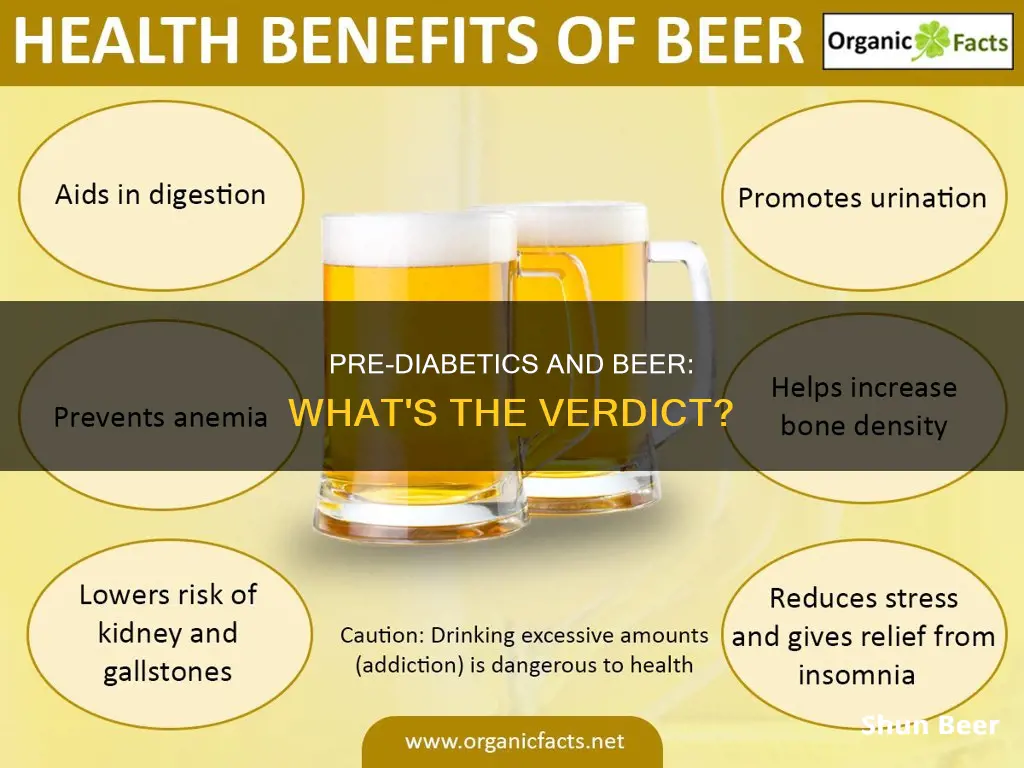
If you have prediabetes, it's important to carefully monitor your food and drink intake. Alcohol can interfere with insulin function and disrupt healthy blood sugar regulation, so it's best avoided. However, if you do choose to drink, it's important to know which drinks are the best and worst options. Beer, for example, is typically higher in carbs than other alcoholic drinks like wine or liquor, but light beers tend to have fewer carbs and a lower alcohol content. So, if you're going to drink beer, it's best to stick to light beers and avoid craft beers, which are higher in carbs and calories.
What You'll Learn

Beer and blood sugar levels
Beer can be a tricky topic when it comes to managing blood sugar levels, especially for those with prediabetes or diabetes. While it is generally advised to limit alcohol consumption, understanding its effects on blood sugar can help make informed choices.
Beer's Impact on Blood Sugar
Beer typically contains carbohydrates, and its consumption can cause an initial spike in blood sugar levels. The amount of carbohydrates varies depending on the type of beer. "Light" beers or low-carb beers usually have fewer carbs, often 5 grams or less per serving, while craft beers like IPAs and stouts tend to have higher amounts, with 15 grams or more per serving. The higher the alcohol content, the higher the number of carbs. Therefore, it is recommended to stick to light beers with lower alcohol by volume (ABV) to keep carb intake in check.
Managing Blood Sugar While Drinking Beer
For those with prediabetes or diabetes, it is crucial to be mindful of how beer consumption can affect blood sugar regulation. Here are some key considerations:
- Moderation: The American Diabetes Association (ADA) recommends no more than one drink per day for women and up to two drinks per day for men. One drink of beer is considered 12 ounces.
- Food Pairing: Drinking beer on an empty stomach can lead to a rapid spike and subsequent drop in blood sugar levels. It is advisable to pair your beer with a balanced meal containing protein, fiber, and healthy fats. This slows down the absorption of alcohol and helps maintain stable blood sugar.
- Monitoring: Check your blood sugar levels frequently, especially before, during, and up to 24 hours after drinking. This proactive monitoring can help you stay within the safe zone, which is typically considered to be 70-180 mg/dL.
- Medication Awareness: If you are taking insulin or insulin-stimulating medications, consult your healthcare provider about adjusting your dosage when consuming alcohol. Alcohol can interfere with insulin function and disrupt healthy blood sugar regulation.
- Hydration: Alcohol can be dehydrating, so remember to drink plenty of water along with your beer to stay hydrated.
- Awareness and Preparedness: Inform your friends about your diabetes and the symptoms of hypoglycemia, which can be similar to those of drinking too much. Carry hypo treatments with you, and always wear medical ID jewellery.
In summary, while beer can be part of a social occasion, it is important to be mindful of its impact on blood sugar levels, especially for those with prediabetes or diabetes. Enjoying beer in moderation, pairing it with food, and closely monitoring blood sugar can help manage its effects on your health.
Beer: Antifreeze Poisoning Cure or Dangerous Myth?
You may want to see also

Alcohol and diabetes medication
If you have diabetes and are taking medication, it's important to know how alcohol may affect you. Alcohol can interfere with diabetes medication, including insulin, and increase the risk of hypoglycaemia (low blood sugar). This is especially true if you consume more than one or two drinks.
Drinking alcohol can lead to serious low blood sugar reactions, particularly if you take insulin or medications that stimulate insulin release. It's important to be cautious and aware of the risks. Alcohol can also affect other medical conditions such as diabetic nerve damage, eye disease, and high blood triglycerides.
- Always consult your doctor or healthcare provider for advice specific to your situation. They can guide you on how to adjust your medication or insulin dosage when consuming alcohol.
- Alcohol competes with your liver's ability to produce glucose when your blood sugar is low. This can lead to dangerously low blood sugar levels for up to 24 hours after drinking.
- To prevent hypoglycaemia, avoid drinking on an empty stomach. Eat food while drinking and monitor your blood sugar levels.
- The recommended alcohol consumption limits are the same for people with diabetes as for the general population: no more than one drink per day for women and up to two drinks per day for men.
- If you use insulin or certain diabetes medications, such as sulphonylureas, you are more likely to experience hypoglycaemia. Alcohol further increases this risk.
- Alcohol can affect your judgment, leading to poor food choices and overeating, which can impact your blood sugar control.
- Beer and sweet wines contain carbohydrates and may raise blood sugar levels.
- Alcoholic drinks are usually high in calories, which can make weight loss more difficult.
- If you choose to drink, it's recommended to drink slowly and only when also eating food.
- Wear a medical alert bracelet or jewellery indicating that you have diabetes.
Naruto Fans: Beer Drinking with a Ninja Twist
You may want to see also

Calories, carbs and sugars in beer
Beer is made by fermenting grains such as barley and wheat, which contain carbohydrates. Most beers also contain added sugars, which further increase the carbohydrate level in the beverage. The number of grains and added sugars that remain in the beer varies according to the fermentation process.
Beer typically contains between 95 and 150 calories per 12-ounce serving. A pint of 4% ABV beer has about 182 calories, whereas a 330ml bottle of beer (5%) has 142 calories. A pint of 0.5% ABV beer has fewer calories from alcohol than a pint of 6.0% ABV – so you should get 12 times fewer calories from the alcohol itself.
The amount of carbohydrates in popular beers will vary based on several factors, such as ingredients and overall sugar levels. In general, light beers are lower in both calories and carbohydrates than many of their full-flavoured counterparts. A "light" beer will typically have 5 grams of carbohydrates or less per serving.
Craft beers like IPAs and stouts tend to be much higher in carbs, usually containing 15 grams or more per serving. They also tend to be higher in calories and alcohol content.
Beer contains small amounts of sugar, but this is rarely added to the drink. Instead, it is produced during the fermentation process when yeast converts the sugars released in malting into alcohol. Because the sugar is converted, it theoretically means that beers have very low sugar. However, light beers often have higher sugar content, and low-alcohol beers can also be quite sugary, as the sugar produced in the malting process is hardly converted by the yeast. In regular beers, the amount of sugar is typically less than 2 grams per litre, or less than 1 gram per pint.
Snoop Dogg's Beer Habits: A Deep Dive
You may want to see also

How to prevent hypoglycaemia
Hypoglycaemia, or low blood sugar, is a dangerous condition that can be life-threatening if left untreated. Here are some ways to prevent hypoglycaemia:
Eat Regularly and Consistently
It is important to eat at least three evenly spaced meals each day and to not skip meals or snacks. Eating small meals regularly, rather than three large meals, is a good way to keep blood sugar levels balanced. Eating a variety of foods, including protein, healthy fats, and fibre, is also recommended.
Monitor Blood Sugar Levels
Frequently checking your blood sugar levels is crucial, especially if you are taking insulin or diabetes medication. This allows you to identify patterns and adjust your diet or medication accordingly. It is also important to know the early warning signs of hypoglycaemia, such as dizziness, a fast heartbeat, and difficulty concentrating, and to treat low blood sugar promptly.
Adjust Medication and Physical Activity
If you increase your physical activity, you may need to adjust your medication or eat additional snacks to maintain stable blood sugar levels. It is important to consult with your doctor about any adjustments to your medication.
Be Mindful of Alcohol Consumption
Drinking alcohol on an empty stomach can cause hypoglycaemia. Alcohol may also cause delayed hypoglycaemia hours later, so it is important to monitor your blood sugar levels closely if you choose to drink. It is recommended to drink alcohol slowly and only when also eating food.
Carry Emergency Supplies
It is important to carry some form of diabetes identification, such as a medical bracelet, so that others will know you have diabetes in case of an emergency. Additionally, carrying a source of glucose, such as glucose tablets or gel, can help you treat low blood sugar promptly if needed.
Beer and Robaxin: Safe After Six Hours?
You may want to see also

Recommended alcohol intake
If you have prediabetes, it's a good idea to cut back on your alcohol consumption and only drink on special occasions. Experts recommend that you stay away from alcohol if you can, or at least limit your intake. Alcohol can interfere with insulin function and disrupt healthy blood sugar regulation, leading to harmful swings in blood sugar that can be very risky. Alcohol can also contribute to weight gain, which is one of the risk factors for diabetes.
If you are going to drink, it's important to be mindful of your intake. The general recommendation for alcohol consumption is the same for people with prediabetes as it is for the general population: no more than one drink per day for women and up to two drinks per day for men. It's important to pace yourself and not overindulge, especially if you are drinking over several hours. A good rule of thumb is to have no more than one drink per hour and to drink plenty of water to stay hydrated.
When it comes to beer, one drink is typically considered to be 12 ounces or one can or bottle. However, it's important to note that some cans and bottles might be more than 12 ounces, so it's always best to check the size. If you're drinking beer on tap, it can be helpful to stick to beers with an ABV of 7% or less to keep your carb intake in check. There are several lower-carb options available, such as Corona Premier, Michelob Ultra, and Coors Light.
It's also important to enjoy a meal with your beer. Drinking on an empty stomach can cause blood sugar spikes and increases the risk of hypoglycemia. Eating a balanced meal with protein, fibre, and healthy fats will help slow the absorption of alcohol and keep blood sugar more stable. Additionally, it's recommended to check your blood sugar more frequently when drinking, both during and up to 24 hours after.
If you are taking insulin or insulin-stimulating medications, it's crucial to be extra cautious while drinking alcohol. Consult your healthcare provider for guidance on how to adjust your medication or insulin dosage on days you consume alcohol.
Beer Lover's Guide: Avoiding the Lingering Beer Smell
You may want to see also
Frequently asked questions
While it is not recommended, it may be okay for prediabetics to drink beer in moderation and on special occasions. However, it is important to limit alcohol intake as it can interfere with insulin function and healthy blood sugar regulation, increasing the risk of developing diabetes.
When choosing a beer, opt for light beers with lower calories and carbohydrates. Examples include Bud Light, Miller Lite, Coors Light, and Michelob Ultra, which have fewer than 5 grams of carbohydrates per 12 ounces.
Beer contains carbohydrates, which can cause blood sugar spikes and subsequent rapid drops, potentially leading to hypoglycemia. This effect is more pronounced when drinking on an empty stomach or in excess. It is important to monitor blood sugar levels before, during, and up to 24 hours after drinking.







